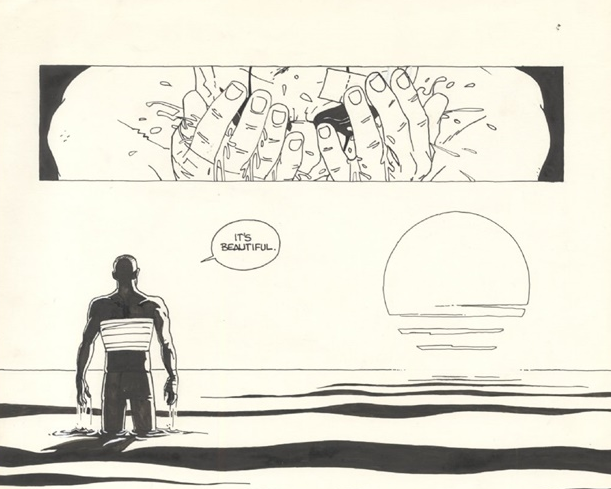 Written by Stan Sakai
Written by Stan SakaiIllustrated by Stan Sakai
Fantagraphics
Now that he's in his own regular series, it's time for an origin story. Usagi relates how he came to be a ronin in the bulk of this second volume of collected stories, showing the signs that would make him the honorable rabbit he is today.
We also get three other, shorter stories, which find Usagi back in his usual mode of running into encounters that require his unique abilities. Will this rabbit on the road ever find a new cause?
I know the origin stories are required, but I have to admit that I wish this one had been a little bit shorter. Since Usagi is a variation on a well-known character type, I could just about write the origin myself in my head. Running roughly 90 pages of echoed story just didn't do a lot for me. But that's more of a reflection of the fact that I watch and read a lot of Japanese samurai stories than on Sakai's ability to tell a good story.
If you aren't as familiar with the genre, Sakai sets things up well. Usagi opts to ignore the safer path of a known school and join a loner who seems to want nothing to do with him. Learning at the knee of a true master, he is able to do the things no one else can do. This puts him in a position of great power, but he pays a huge price for his loyalty. He also makes a a fateful choice that probably denies him true love, but that is the way of the warrior.
Again, it's not anything out of the ordinary, but it's solid storytelling. I did like the fact that Sakai sets this up by having Usagi relate this tale to the bounty hunter Gen. Gen's code had no room for honor, and he's baffled by the way Usagi acts throughout the origin. It's a great way of questioning the actions of a samurai without making the main character look less than honorable. Gen may appear to be crude, but he's also more of a realist. Who is to say which of them has the better outlook on life?
Once we move on into the series of one-shots, I enjoyed this volume a lot more. In the first, Usagi must try to outwit a water creature that requires a harsh toll--cucumbers or your life! (I'd be screwed; I hate cucumbers.) Sakai adds a layer of mystery to the proceedings and we end up with a story that shows a mystical side to the Usagi Yojimbo world. Though it's a very short story, we get a tale that both engages the reader and helps to open up the realm of the story into other areas down the road. That to me is the best kind of story.
The next two features owe a debt to Sakai's Groo collaborator, the great writer Mark Evanier. Evanier provides an introduction to this volume, but his biggest contribution is rubbing off on Sakai in terms of writing an entire story around one incredibly funny joke. I won't spoil it, but suffice it to say an ordinary story about bandits trying to take Usagi's money ends up with a punchline that made me laugh out loud, and I bet you'll do the same.
The final story also has the feel of Evanier because of its subtle social commentary. Usagi encounters a community of silk workers who can barely make ends meet because the boss pays them only subsistence wages--if that. He's a skinflint who even cheaps out on security. That's where Usagi comes in. He'll help the owner--but only if he pays what he owes to his workers. The theme of oppressive rich people who only think of themselves is one I've read a time or three in Groo. It's nice to see Sakai's take on it here.
Like Evanier, the social message does not overpower the story, but it's there if you know where to look. I'll be curious to see if Sakai does the same thing in the future volumes.
While I enjoyed Sakai's artwork in the first volume, this second trade collection is even stronger. The character designs are getting more varied, giving us more creatures to populate the world. His ninja cats look even creepier than they did the last time out. As with his friend Sergio Aragones, Sakai's style is deceptively detailed and the results are stunning.
However, I think it's the faces that impress me the most. The expressions of the characters, particularly Usagi himself, are amazing. These are animals with animal-looking features, and yet Sakai manages to give them human emotion without morphing them into human-looking animals. He takes advantage of the lines on the original creatures' faces instead, and uses them to provide the defining lines.
I'm not a big fan of talking animal comics, but Sakai makes it work. I'm so glad I'm finally sitting down and reading this series, and my only regret is that I didn't do it sooner. Usagi Yojimo is a great addition to the canon of samurai stories, and is definitely highly recommended for anyone who is a fan of wandering ronin or just good storytelling.







